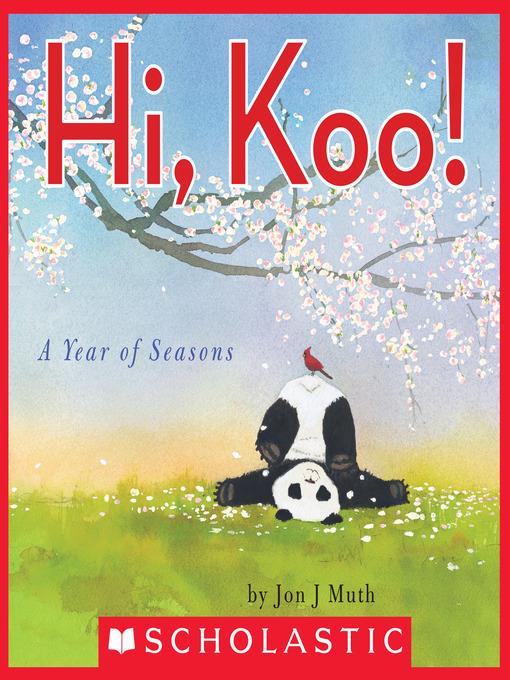
Hi, Koo!
Stillwater the Panda
فرمت کتاب
ebook
تاریخ انتشار
2015
Reading Level
0-1
ATOS
2.3
Interest Level
K-3(LG)
نویسنده
Jon J. Muthناشر
Scholastic Inc.شابک
9780545777643
کتاب های مرتبط
- اطلاعات
- نقد و بررسی
- دیدگاه کاربران
نقد و بررسی

Starred review from December 2, 2013
Twenty-six gossamer watercolors celebrate the changing seasons with Koo, the young panda Muth introduced in Zen Ties (he’s the nephew of Stillwater, Muth’s famous panda sage). Each page features a haiku about an evocative moment (eating cookies, accidentally killing an insect) or small natural miracle (crocuses, fireflies), which, in turn, contains a word that begins with a letter of the alphabet. In the “D” haiku (“Dance through cold rain/ then go home/ to hot soup”), Koo mimics Gene Kelly, hanging off a street lamp and beaming in the rain; a second vignette shows Koo seated at the lunch table. White space is used to marvelous effect. On the “K” page, a cardinal sits on a branch against a backdrop of white, while Koo smiles from beneath it under a headdress of snow: “King!/ my crown a gift/ from a snowy branch.” In spring, Koo frolics on a grassy hill, his stubby legs up in the air, then tickles a friend with a flower for “V” (“Violet petal/ caressing a cheek/ butterfly kisses”). It’s a joyous addendum to the Stillwater books, and it overflows with the same characteristic tenderness. Ages 4–8. Agent: Allen Spiegel, Allen Spiegel Fine Arts.

Starred review from January 15, 2014
Long before photography, poets took to haiku, the poetic equivalent of a snapshot, and painters, to the suggestive medium of watercolor to capture the essence of moments in nature. Caldecott Honoree Muth (Zen Shorts, 2005) employs both, with the help of his playful panda Koo, to present 26 moments through the seasons. Though light in tone and geared toward pre-reader eyes and interests, the mostly outdoor scenes Muth depicts command serious attention from all. The first page simultaneously demonstrates both Muth's adherence to haiku's three-line form rather than its traditional five-seven-five syllabic sequence and his exquisite use of white space. "Autumn, / are you dreaming / of new clothes?" reads the text as Koo reaches up to try to catch a handful of falling leaves. One of the few scenes referencing indoor living hilariously comes in early spring: "too much TV this winter / my eyes are square / let's go Out and play." Two children and Koo stand in front of a large television, the whites of the children's eyes boxed and zombielike and Koo's, two solid black squares. A more reflective, deeply moving spring moment finds the children alone with a book in the woods, Muth's delicate watercolor and subtle inking deftly suggesting the forest's shifting scope. Throughout, condensed poetic image coupled with spare illustration yields huge effect; in a word, magical. (Picture book/poetry. 3 & up)
COPYRIGHT(2014) Kirkus Reviews, ALL RIGHTS RESERVED.

February 1, 2014
K-Gr 4-Muth, in his author's note, says "haiku is like an instant captured in words." Indeed, that is evident in 26 poems depicting images across four seasons, starting with fall. Muth's well-known panda, Koo, is depicted on a white background with just a touch of blue sky, looking up at swirling leaves: "Autumn/are you dreaming /of new clothes?" Koo, who begins alone, is soon joined by two children for the rest of the seasons. In the spring, birds alight on Koo, the girl, and on a branch held by the boy: "Quiet and still/long enough/for birds to make nests?" The color palette for the contemplative watercolors changes through the seasons, with a red-striped scarf and cardinal contrasting against the panda and the white snow. When a crown of snow falls on Koo he exclaims, "King!/my crown a gift/from a snowy branch." Muth's author's note also explains his variation from the traditional five-seven-five poetic form and invites readers to follow "an alphabetical path through the book by following the capitalized words in each haiku." While others haiku picture books include Andrew Clements's Dogku (S & S, 2007), Bob Raczka's Guyku (Houghton Harcourt, 2010), and Rita Gray's One Big Rain (Charlesbridge, 2010), no previous titles so cohesively capture the naturalistic spirit of Japanese haiku. Even readers who are not typically interested in poetry will be captivated by Muth's artistry in both words and images.-Julie R. Ranelli, Queen Anne's County Free Library, Stevensville, MD
Copyright 2014 School Library Journal, LLC Used with permission.

December 15, 2013
Preschool-G First introduced in Zen Ties (2008) as Stillwater the panda's nephew, Koo is alone in the narrative world of this verse collection, until a boy and girl from the neighborhood knock on his door. They share good times throughout the seasons, whether throwing snowballs, reading aloud to sparrows, or skipping stones. And sometimes Koo enjoys reflective moments alone, becoming so quiet / Zero sound / only breath. These very short poems, ranging from fresh to poignant to prosaic, are enhanced by the beautiful watercolor-and-ink illustrations on every page. Reflecting the brevity and imagery of the verse, the spare fall and winter pictures seem particularly fine, while their relative simplicity contrasts effectively with the profusion of color in the spring and summer scenes. Besides pointing out the subtle trail of alphabetically arranged capital letters in each poem throughout the book, the author's note expresses Muth's rationale for not restricting himself to the five-seven-five syllable pattern that many of us grew up learning haiku must be. Haiku or not, this collection is worth reading.(Reprinted with permission of Booklist, copyright 2013, American Library Association.)

























دیدگاه کاربران